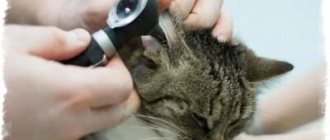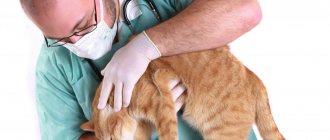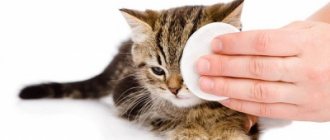As you know, the hearing organs for cats are as important as the sense of smell, sight, and touch.
Unfortunately, even pets that do not leave the apartment are not immune from otitis media. It is necessary to treat otitis in cats at an early stage, since the process from the external auditory canal, in the absence of help, quickly moves to the middle and then to the inner ear. Cat owners, when faced with a similar problem, often ignore the disease or do not know how it can be cured. First of all, it is necessary to find out the cause of the inflammatory phenomenon, but this cannot be done at home, so you should not delay a visit to the veterinarian.
Types of otitis media in cats
Otitis in cats is a disease that is accompanied by inflammatory processes in the ears of animals. Sometimes inflammation develops rapidly (acute course) or occurs almost unnoticed for a long time (chronic course).
The disease can occur at any age, regardless of the gender or breed of the cat. The main risk group includes animals with poor immunity, weakened, and elderly pets.
In most cases, otitis media begins with inflammation of the external auditory canal. If detected early and treated appropriately, the cat will make a full recovery.
If you ignore the symptoms, the inflammation spreads to the middle and inner ear. Inflammation of the middle ear, although it occurs in a more severe form, is treatable in the early stages. If inflammation of the inner ear is allowed, the process may drag on for several months. Otitis media can lead to hearing problems and other complications that can cause the cat's death.
Localization of the inflammatory process:
- external: the inflammatory process occurs in the outer part of the auricle;
- medium: inflammation covers the external auditory canal, descends deep into the auricle beyond the border of the outer ear, right up to the eardrum;
- internal: accompanied by inflammation of the inner ear, including tissues that are outside the eardrum, such as the auditory nerve, cochlea, and ossicles.
The disease usually occurs in one ear, but if treatment is not taken, it quickly spreads to the second ear.
Purulent otitis media
Suppurative otitis is usually localized in the middle, inner ear of a cat. In addition to general signs such as restlessness, itching, there are a number of specific symptoms.
Signs of purulent otitis:
- the animal will tilt its head towards the sore ear;
- redness, swelling of the visible ear coverings;
- hearing impairment, the cat does not respond to the sounds of its name;
- upon examination, an increase in ear temperature is noted;
- increased body temperature;
- pain on palpation of the ear and nearby tissues;
- purulent, bloody or serous discharge from the ear canal;
- the putrid odor of their ears;
- scratches, sores, cracks on the visible part of the auricle;
- inflammation of the submandibular lymph nodes;
- apathy, depressed state, the animal hides in dark, cool places;
- deterioration or complete loss of appetite, vomiting;
- when pressing on the auricle, a characteristic squelching sound is heard;
- lack of coordination;
- salivation, lacrimation, purulent discharge from the eyes;
- the ear droops or bends to the side.
In acute cases (in the internal section), paralysis of the cat's facial nerve is noted. The lip, jaw and eyelid droop (lean) towards the affected ear. When the cerebral cortex is damaged, the animal experiences convulsive contractions of muscle tissue, as well as seizures similar to epileptic seizures.
When the eardrum ruptures, pus can drain not only through the ear, but also flow through the mouth and nasal cavity.
Bacterial otitis
The causes of bacterial inflammation can be microtrauma, ear parasites, fungus, decreased immunity, hormonal imbalance, previous infectious disease, allergic reactions.
In most cases, bacterial otitis in cats develops as a secondary disease when pathogenic microflora enters the animal's body. Bacterial otitis media, typical symptoms:
- restlessness, itching;
- redness, swelling of the internal visible integument;
- wounds, ulcers, cracks, as well as other violations of the integrity of the inner ear.
Typically, bacterial otitis occurs as a complication of infectious diseases of the respiratory system. But there are often cases of ear injury when cleaning the inside of the ear using unsuitable tools and materials.
Fungal otitis media
Fungal otitis media is a fairly serious disease in which immediate care is important. Most likely, surgery will be required, as well as a long course of treatment and rehabilitation. In severe cases, if left untreated, the cat dies.
A number of atypical signs can be misleading, since only veterinarians can make a final diagnosis. Therefore, at the first signs, you need to go to the clinic to undergo an examination and get tested.
Signs of fungal otitis:
- severe inflammation of the internal skin;
- itching, pain on palpation, scratching;
- upon examination, gray-green deposits are visible on the surface of the auricle;
- growths or gouges on soft tissues, which, if left untreated for a long time, can reach cartilage tissue.
In severe cases, the entire inside of the ear canal is clogged with fungal formations similar to mold, cotton wool or filter paper.
Parasitic otitis media
In this case, the main cause of inflammation is Otodectes mites. The disease caused by mites is called otodectosis or ear scabies. Less commonly, the inflammatory process can occur with severe flea infestation, notoedrosis, and sarcoptic mange. The vital activity of mites leads to the development of inflammation on the cat’s skin, increased secretion of sulfur, microcracks, and scratching.
Typical signs of parasitic otitis media:
- small ulcers on the inner skin;
- unpleasant odor from the ear;
- dense dark brown discharge that can completely block the internal auditory canal.
Otodectosis is contagious and is often transmitted from a sick animal to a healthy one, so contact with potentially sick pets should be avoided.
Allergic otitis media
Allergic otitis media develops rapidly from several hours to a day. The disease can develop against the background of food allergies or be a secondary process in ear scabies (otectosis).
Allergic otitis in cats, typical signs:
- severe swelling of the ear tissues, including the auricle, middle, and also the inner part of the ear canal;
- increase in local temperature;
- Watery blisters, ulcers, and scratches appear on the skin;
- with complex development, hair loss on the ears is noted;
- Allergic otitis media is often accompanied by swelling of the eyelids, nose, larynx, and tongue.
The acute course of the disease may be accompanied by serous discharge, unpleasant odor, salivation, lacrimation and other associated symptoms.
How to treat and avoid the disorder?
Treatment is prescribed depending on the causes of inflammation, for example, for otitis media, the drug Dexamethasone is prescribed.
Treatment is selected based on research results, and regular treatment of the ear canals is often sufficient. To eliminate the symptoms of otitis media, glucocorticoid drugs are prescribed, for example, Dexamethasone. If the problem of ear discharge in cats is an allergic reaction, then the shells of the organs are treated with special solutions and the animal is given antihistamines that eliminate allergies. In this case, be sure to immediately exclude the irritant that caused the cat to develop an unpleasant exudate.
When a cat is bitten by a tick, a dry, dark exudate is noticed, similar in appearance to coffee grounds. The disorder must be treated for 1-2 weeks until all pathological signs have completely disappeared. Ear problems caused by yeast can be treated with daily cleaning and medication. Antibiotics are required in case of bacterial infection to prevent it from spreading into the deep ear structures.
It is easier to prevent a disorder than to treat it. To do this, you need to keep the cat’s ears clean, but avoid getting water in the water procedures. It is equally important to feed the animal high-quality and healthy food so that the protective functions of the immune system do not decrease. If your pet goes outside, then after a walk you should inspect the ears and check for ticks in them. At the first pathological symptoms, you should contact a veterinarian to clarify the diagnosis and exclude serious diseases.
Symptoms of otitis media in a cat
Inflammation of the outer and middle ear can be asymptomatic up to a certain stage, so it is necessary to regularly examine the ears for warning signs.
General symptoms of the disease:
- itching, the animal constantly scratches the ear, shakes its head;
- redness of the visible part of the ear;
- discharge of various types;
- depressed state;
- loss of appetite;
- unpleasant odor;
- soreness, the pet does not allow you to examine the ear;
- cracks, sores, blisters on the skin.
Any symptoms are the first signal that the cat needs to be taken to an appointment with a veterinarian. Only an experienced doctor can make a diagnosis and prescribe treatment!
Natural causes
Brownish discharge is practically the only type of ear discharge that can appear for physiological reasons. This phenomenon is due to increased activity of the sulfur glands: during the hot season, with a sharp change in climatic conditions or with serious physical activity. As a result, body temperature and sweating increase, the cerumen glands begin to produce excess secretion (wax), and a brown substance appears, which is earwax with a softened consistency. This is a normal physiological process that gives no cause for alarm.
Treatment of otitis media in cats at home
It is better not to self-medicate, especially in severe cases. But if the overall picture of the treatment is favorable and the cat feels well, then you can relieve minor inflammation and help the cat with folk remedies.
Treatment of otitis with folk remedies:
- Fungal otitis in cats: an alcoholic infusion of calendula is instilled into the ear. At the rate of 1 teaspoon of tincture per half glass of water.
- Relieves inflammation: geranium juice, boiled bay decoction (3 leaves per 100 ml of water), propolis tincture in water.
It is advisable to use all medications and traditional methods only after consulting a veterinarian. Since self-medication can lead to a deterioration in the cat’s condition and the development of secondary diseases.
In what cases is it necessary to contact a veterinarian?
Since otitis media is an extremely dangerous disease, it is necessary to pay attention to any strange and alarming behavior of the cat. Here are the cases in which you will need to contact a veterinarian:
- The animal clearly shows signs of damage to the vestibular apparatus (the animal cannot maintain stability, falls out of the blue, etc.).
- Pets that are experiencing neurological seizures should be taken immediately to the veterinarian. These signs indicate damage to the central nervous system.
- You also cannot do without the help of a specialist in cases where the animal completely refuses food for a day or more. In addition, it is urgent to take the cat to the doctor if the pet does not drink.
- Veterinary care is required for cats suffering from unbearable pain and itching.
- In addition, it is necessary to contact the clinic if the animal is too apathetic, does not react to anything, or lies flat.
Prevention of otitis in cats
To reduce the risk of developing the disease, it is necessary to follow preventive measures.
Prevention of the disease:
- Follow hygiene procedures.
- Conduct preventive examinations. On your own once a week and at least once every six months with a veterinarian.
- Do not allow water or foreign objects to get into the ear.
- Avoid hypothermia and drafts.
- Watch your diet.
- Follow the schedule of antiparasitic treatment and vaccination.
- Avoid contact with stray animals.
Otitis media in cats is not dangerous to humans, but can cause infection in other pets. After all procedures, you must wash your hands with soap and treat with a disinfectant. Contact with other pets should be avoided. Provide the cat with peace, good nutrition and a cozy atmosphere in the house.
Establishing diagnosis
In case of discharge and pain in the ears, you should always consult a doctor so that an accurate diagnosis can be made.
At worst, untreated ear infections can become chronic and affect the patient for the rest of their life. A number of studies and tests are offered to make a diagnosis. The doctor will first check your medical history to determine which symptoms are present. He will then examine the ear canal more closely using an ear mirror (otoscopy), whereby he will visually examine the inner ear using an ear specula. Inflammation, with local hyperemia or bulging of the eardrum, is noticeable even during the initial examination.
If necessary, the ENT doctor can additionally check the mobility of the eardrum and how well the Eustachian tube functions.
Possible forecast
If an additional bacterial infection occurs during a simple inflammation, the discharge has an unpleasant odor and turns greenish-yellow in color.
The long-term existence of such a lesion can lead to a chronic course. And this can already lead to serious hearing impairment. In almost every case, this indicates the spread of inflammation to the deeper organs of hearing, including the eardrum.
If, despite adequate conservative therapy, no improvement is observed, invasive or surgical treatment may be used.











